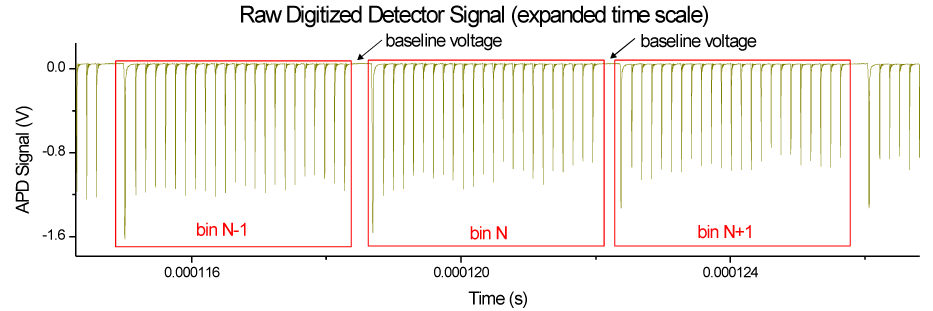Processing of Raw Data Acquired from the APD
- The APD has an internal linear preamplifier, the output voltage
is proportional to the x-ray intensity. The linearity is checked
before each series of measurements as very high x-ray intensity can
cause saturation.
- The APD signal is directed into a digitizing oscilloscope.
At each x,y position, the oscilloscope averages the results of several
sprays, and the data is then transferred to a PC for storage.
Note that all averaging is done in the oscilloscope, and only the final
averaged results are stored on the PC. Therefore, we do not typically
keep the single-shot results.
- The "raw" APD data looks like the following:

- If we expand the time axis of this plot, we can zoom in on the
region of interest indicated by the box labeled "zoom region".
This looks like the following:

- Note that the APD response is a negative voltage signal, each
pulse of the APD signal corresponds to a single x-ray pulse. The
APD pulses are ~10 ns wide (FWHM), therefore our digitizer must record
a data point every 2 ns at the
slowest in order to capture the shape of these pulses. Also note
the repeating pattern of the APD pulses. This is due to the fact
that we are using a synchrotron source, the pulse pattern repeats every
3.6825 microseconds, which is the time of a single orbit around the
synchrotron. For this particular data set, there is a single
large pulse followed by 22 smaller pulses and then a gap, all equally
spaced around the synchrotron. Note that this pulse pattern can
vary depending on the operating mode of APS. Each individual
x-ray pulse does not contain enough photons for a statistically
significant measurement of the x-ray absorption, therefore we combine
the results from several consecutive x-ray pulses to get a
statistically significant measurement. This process is
illustrated in the image above. For each red box, all of the
pulses inside that particular box are "binned" together by summing the
integration of each individual peak. In effect, we are decreasing our
time resolution to gain statistics. Each of the time bins then
contributes a single data point to the following plot:

- In the image above, each data point represents a single bin from
the previous image. In effect, we are taking our original raw
data and discarding all the extraneous information, with a time
resolution of 3.682 microseconds. In our group, we refer to each time
step in the above plot as a "Snapshot", as if we had a camera with a
shutter speed of 3.682 microseconds. Each snapshot is numbered
starting from 1, and we sometimes interchange snapshot number for the
time axis. In the image above, the first 100 microseconds of data is
acquired before the spray has intersected the x-ray beam. We use
this region of the data as our incident beam intensity, and we
normalize the entire plot to the average in this region. In this
way, the measurement is self-normalizing, and any attenuation from the
x-ray windows, fuel droplets on the windows, detector response, beam
intensity, etc are all normalized for every individual
measurement. This normalization process results in the following
plot:

- The image above shows the x-ray transmission, in which the data
has been normalized to the baseline x-ray intensity. A
transmission of unity indicates the full x-ray beam hitting the
detector, less than one indicates that the beam has been attenuated by
the spray. Because we use a monochromatic x-ray beam, there is a
simple relationship between the transmission and the mass of fuel in
the path of the beam. This is shown in the following image:

- In this image, we have converted from transmission to mass.
This is measured as a function of time, in steps of 3.682
microseconds. Data in this form is much more compact than the raw
data, is easier to manipulate, and results in very little loss of
information.









